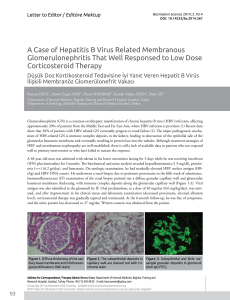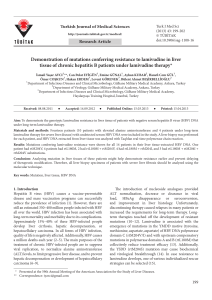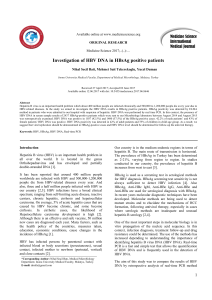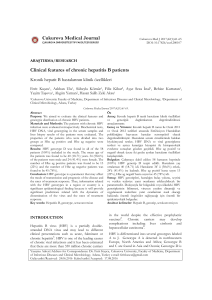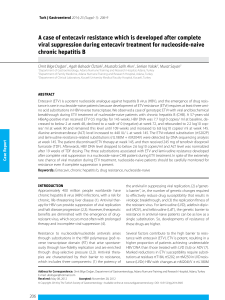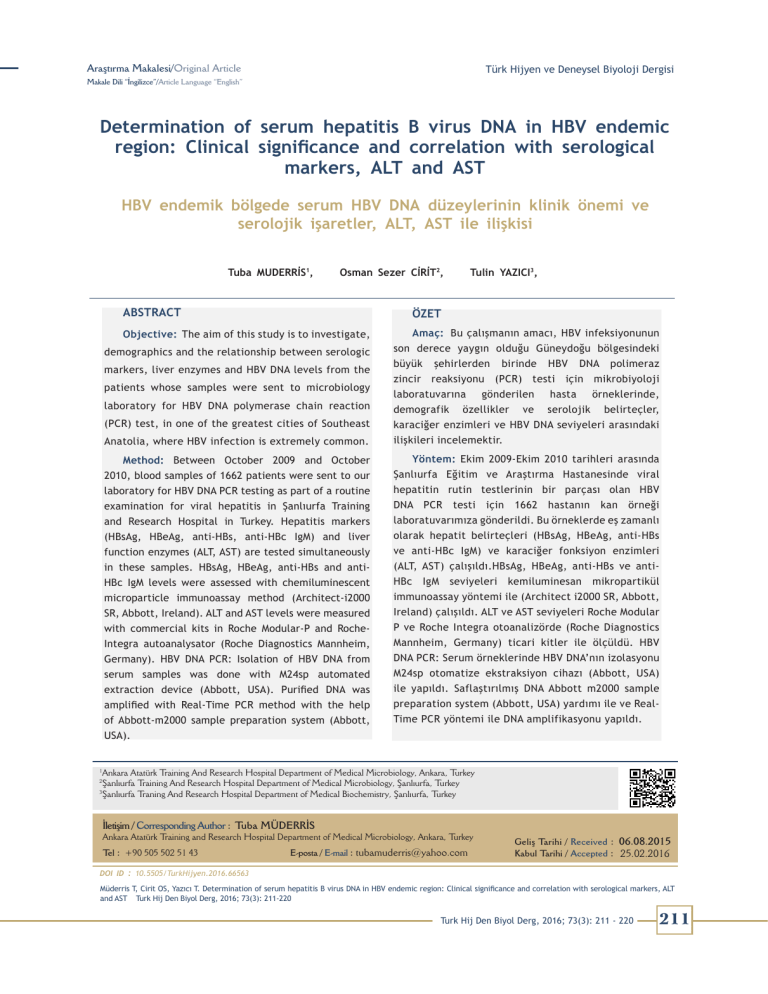
Araştırma Makalesi/Original Article
Türk Hijyen ve Deneysel Biyoloji Dergisi
Makale Dili “İngilizce”/Article Language “English”
Determination of serum hepatitis B virus DNA in HBV endemic
region: Clinical significance and correlation with serological
markers, ALT and AST
HBV endemik bölgede serum HBV DNA düzeylerinin klinik önemi ve
serolojik işaretler, ALT, AST ile ilişkisi
Tuba MUDERRİS1,
Osman Sezer CİRİT2,
ABSTRACT
ÖZET
Objective: The aim of this study is to investigate,
demographics and the relationship between serologic
markers, liver enzymes and HBV DNA levels from the
patients whose samples were sent to microbiology
laboratory for HBV DNA polymerase chain reaction
(PCR) test, in one of the greatest cities of Southeast
Anatolia, where HBV infection is extremely common.
Method: Between October 2009 and October
2010, blood samples of 1662 patients were sent to our
laboratory for HBV DNA PCR testing as part of a routine
examination for viral hepatitis in Şanlıurfa Training
and Research Hospital in Turkey. Hepatitis markers
(HBsAg, HBeAg, anti-HBs, anti-HBc IgM) and liver
function enzymes (ALT, AST) are tested simultaneously
in these samples. HBsAg, HBeAg, anti-HBs and antiHBc IgM levels were assessed with chemiluminescent
microparticle immunoassay method (Architect-i2000
SR, Abbott, Ireland). ALT and AST levels were measured
with commercial kits in Roche Modular-P and RocheIntegra autoanalysator (Roche Diagnostics Mannheim,
Germany). HBV DNA PCR: Isolation of HBV DNA from
serum samples was done with M24sp automated
extraction device (Abbott, USA). Purified DNA was
amplified with Real-Time PCR method with the help
of Abbott-m2000 sample preparation system (Abbott,
USA).
1
2
3
Tulin YAZICI3,
Amaç: Bu çalışmanın amacı, HBV infeksiyonunun
son derece yaygın olduğu Güneydoğu bölgesindeki
büyük şehirlerden birinde HBV DNA polimeraz
zincir reaksiyonu (PCR) testi için mikrobiyoloji
laboratuvarına gönderilen hasta örneklerinde,
demografik özellikler ve serolojik belirteçler,
karaciğer enzimleri ve HBV DNA seviyeleri arasındaki
ilişkileri incelemektir.
Yöntem: Ekim 2009-Ekim 2010 tarihleri arasında
Şanlıurfa Eğitim ve Araştırma Hastanesinde viral
hepatitin rutin testlerinin bir parçası olan HBV
DNA PCR testi için 1662 hastanın kan örneği
laboratuvarımıza gönderildi. Bu örneklerde eş zamanlı
olarak hepatit belirteçleri (HBsAg, HBeAg, anti-HBs
ve anti-HBc IgM) ve karaciğer fonksiyon enzimleri
(ALT, AST) çalışıldı.HBsAg, HBeAg, anti-HBs ve antiHBc IgM seviyeleri kemiluminesan mikropartikül
immunoassay yöntemi ile (Architect i2000 SR, Abbott,
Ireland) çalışıldı. ALT ve AST seviyeleri Roche Modular
P ve Roche Integra otoanalizörde (Roche Diagnostics
Mannheim, Germany) ticari kitler ile ölçüldü. HBV
DNA PCR: Serum örneklerinde HBV DNA’nın izolasyonu
M24sp otomatize ekstraksiyon cihazı (Abbott, USA)
ile yapıldı. Saflaştırılmış DNA Abbott m2000 sample
preparation system (Abbott, USA) yardımı ile ve RealTime PCR yöntemi ile DNA amplifikasyonu yapıldı.
Ankara Atatürk Training And Research Hospital Department of Medical Microbiology, Ankara, Turkey
Şanlıurfa Training And Research Hospital Department of Medical Microbiology, Şanlıurfa, Turkey
Şanlıurfa Traning And Research Hospital Department of Medical Biochemistry, Şanlıurfa, Turkey
İletişim / Corresponding Author : Tuba MÜDERRİS
Ankara Atatürk Training and Research Hospital Department of Medical Microbiology, Ankara, Turkey
Tel : +90 505 502 51 43
E-posta / E-mail : [email protected]
Geliş Tarihi / Received : 06.08.2015
Kabul Tarihi / Accepted : 25.02.2016
DOI ID : 10.5505/TurkHijyen.2016.66563
Müderris T, Cirit OS, Yazıcı T. Determination of serum hepatitis B virus DNA in HBV endemic region: Clinical significance and correlation with serological markers, ALT
and AST Turk Hij Den Biyol Derg, 2016; 73(3): 211-220
Turk Hij Den Biyol Derg, 2016; 73(3): 211 - 220
211
Cilt 73 Sayı 3 2016
HBV-DNA CORRELATION WITH SEROLOGICAL MARKERS, ALT, AST
Results: The mean age was 33.7 (Min-Max: 0-89)
years old and the majority of the patients were male
(Male/Female: 1103/559) in the study. HBsAg was
positive in 96.2% of the patients and the median ALT
level of these patients were 94 u/l (Min-Max: 4-2390
u/l), while median AST level was 74 u/l (Min-Max:
7-2505 u/l). HBV DNA was positive in 94.6% of HBsAg
positive patients and the median HBV DNA level was
3.9x104 copies/ml (Min-Max: 35-3.4x109 copies/ml).
HBeAg was positive in 17.1% of HBsAg positive patients.
Median levels of ALT and AST in HBsAg negative patients
(3.8%) were 32 u/l (Min-Max: 7-497 u/l) and 33 u/l (MinMax: 13-280 u/l) respectively. HBV DNA was positive in
only 7.9% of the patients with median HBV DNA level of
155 copies/ml (Min-Max: 34-624 copies/ml). HBeAg was
found negative in 71.4% of patients with negative HBsAg
and positive HBV DNA. In 26 of 1662 patients (1.6%),
both HBsAg and Anti-HBs were negative (N/N). Only two
of the N/N patients (7.7%) were found anti-HBc positive.
Mean ALT and AST levels of two anti-HBc positive patients
were 29.5 u/l and 30.5 u/l, respectively. HBV DNA was
negative in one of these patients, and the other was
found positive with a level of 3×102 copies/ml.
Bulgular: Çalışmamızda ortalama yaş 33,7
(Min-Maks: 0-89) ve örneklerin çoğunluğu erkek
cinsiyettedir (Erkek/Kadın: 1103/559). Hastaların
%96.2’sinin HBsAg’si pozitifti ve bu hastaların
ortanca ALT seviyesi 94 u/l (Min-Maks: 4-2390 u/l)
iken, ortanca AST seviyesi 74 u/l (Min-Maks: 7-2505
u/l)’dir. HBsAg pozitif hastaların %94.6’sında HBV DNA
pozitif ve ortanca HBV DNA düzeyi 3.9x104 kopya/ml
(Min-Maks: 35-3.4x109 kopya/ml)’dir. HBsAg pozitif
hastaların %17.1’inde HBeAg pozitif idi. HBsAg negatif
hastaların (%3.8) ortalanca ALT ve AST düzeyleri
sırasıyla 32 u/l (Min-Maks: 7-497 u/l) ve 33 u/l (MinMaks: 13-280 u/l)’dir. HBV DNA hastaların sadece
%7.9’unda pozitifti ve ortanca HBV DNA seviyesi 155
kopya/ml (Min-Maks: 34-624 kopya/ml) idi. HBsAg
negatif ve HBV DNA pozitif hastaların %71.4’ünde
HBeAg negatif bulundu. 1662 hastanın 26 (%1.6)’sında
HBsAg ve Anti-HBs’ nin her ikisi de negatif (N/N)
idi. Bu N/N hastalarının sadece ikisi (%7.7) anti-HBc
pozitif bulundu. İki anti-HBc pozitif hastanın ortalama
ALT ve AST seviyeleri sırasıyla 29.5 u/l ve 30.5 u/l idi.
Bu hastaların birinin HBV DNA’sı negatif idi ve diğeri
3×102 kopya/ml ile pozitif bulundu.
Conclusion: To acquire more reliable results on the
diagnosis and follow-up of the treatment of Hepatitis B,
quantitative HBV DNA tests should be used in together
with more frequently used serologic and biochemical
methods.
Sonuç: Hepatit B infeksiyonlarının tanısında
ve tedavisinin takibinde daha güvenilir sonuçlar
elde edebilmek için daha sık kullanılan serolojik ve
biyokimyasal testler ile birlikte kantitatif HBV DNA
testleri kullanılmalıdır.
Key Words: HBV DNA, HBsAg, HBeAg, Anti-HBs,
Anti-HBc, ALT, AST
Anahtar Kelimeler: HBV DNA, HBsAg, HBeAg, AntiHBs, Anti-HBc, ALT, AST
INTRODUCTION
Hepatitis B virus (HBV) is a noncytopathic,
million people worldwide and it is endemic in Asia
hepatotropic virus of the Hepadnaviridae family that
and Africa (1). It will increase by nearly 50 million
causes variable degrees of liver disease in humans.
people a year with nearly two million deaths related
HBV carriers are at risk of developing life threatening
to acute and chronic complications of HBV. World
cirrhosis (30%) and later on hepatic carcinoma (6-
Health Organization reported that the virus causes
17.5%). Despite the availability of a prophylactic
hepatic carcinoma over 300.000 patients annually.
vaccine, HBV is estimated to infect around 400
HBV carriers are the most important factor in the
212
Turk Hij Den Biyol Derg
T. MUDERRİS, O. S. CİRİT and T. YAZICI
Cilt 73 Sayı 3 2016
dissemination of HBV infection. Turkey is among the
antiviral therapy. (6). The correlation between the
moderate endemic regions with a carrier rate of 3.9-
HBsAg and the number of HBV particles is a key
12.5%. Various studies revealed even higher rates
point, since this marker is used with a wide range of
in Eastern and Southeastern regions of Turkey with
HBV particles in blood, depending on the infections
remarkable rates of childhood transmission (2).
state (7). Clinical liver function biomarkers, used
Viral antigens and antibodies that emerge against
for the diagnosis of liver damage and/or evaluation
them, are commonly used in diagnosis and for
of treatment includes alanine aminotransferase
determination of the prognosis of HBV infection (3).
(ALT) and aspartate aminotransferase (AST) (8). Due
Serological tests can provide accurate information
to serious clinical problems that the infection may
about acute, chronic or previous HBV infection.
cause and the potential for obstinacy, accurate use
Routine serological tests that are used in the diagnosis
and interpretation of laboratory tests have a crucial
of HBV are; Hepatitis B surface antigen (HBsAg),
role in the diagnosis of the infection (4).
hepatitis B surface antibody (anti-HBs), hepatitis
In this study, patient demographics and the
B core antibody (anti-HBc), hepatitis B envelope
relationship between serologic markers, liver enzymes
antigen (HBeAg) and HBe antibody (anti-HBe) (4).
and HBV DNA levels are investigated in patient samples
HBsAg is the most important marker for the
that were sent to our microbiology laboratory for HBV
diagnosis of acute and chronic hepatitis B virus and
DNA polymerase chain reaction (PCR) test, in one of
indicates potential infectiousness. It is one of the first
the developed cities of Southeastern region of Turkey,
serum markers to appear during the course of HBV
where HBV infection is extremely common.
infection. It is also useful as a follow-up marker, since
declining concentrations are observed in resolving
hepatitis B. HBsAg usually becomes undetectable
after 4-6 months. If HBsAg persists for more than 6
months, the infected individual is considered as a
chronic HBV carrier. Anti-HBs antibodies become
detectable late in convalescence. Hepatitis B e
antigen (HBeAg) protein appears shortly after the
appearance of HBsAg and disappears within several
weeks as acute hepatitis resolves. Its presence in the
serum correlates with presence of viral replication in
the liver. Antibody to hepatitis B core antigen (AntiHBc) IgM is detectable at the outset of clinical disease
and as the infection evolves, it gradually decline and
become undetectable within six months. Anti-HBc
IgG predominates and remains for a long time at
detectable levels (5).
MATERIAL and METHOD
This study was carried out between 01 October
2009 and 31 October 2010. Blood samples of 1662
patients were sent to our laboratory for HBV DNA
PCR testing as part of a routine examination for viral
hepatitis in Şanlıurfa Training and Research Hospital,
Turkey. Hepatitis markers (HBsAg, HBeAg, anti-HBs
and anti-HBc IgM) and liver function enzymes (ALT,
AST) are tested simultaneously in these samples.
HBsAg, HBeAg, anti-HBs and anti-HBc IgM levels
were assessed with chemiluminescent microparticle
immunoassay method with Architect i2000 SR
(Abbott, Ireland) system.
ALT
and AST
levels
were
measured
with
commercial kits in Roche Modular P and Roche Integra
autoanalysator
(Roche
Diagnostics
Mannheim,
Germany). The normal concentrations in the blood
Lately, detection of HBV DNA in the serum and
viral quantitation have an increasingly important
were between 5 to 41 U/L for AST and 5-38 u/l for
ALT.
role in diagnosis of the disease, designing the
Isolation of HBV DNA from serum samples was done
treatment and determination of the efficacy of
with M24sp automated extraction device (Abbott,
Turk Hij Den Biyol Derg
213
HBV-DNA CORRELATION WITH SEROLOGICAL MARKERS, ALT, AST
Cilt 73 Sayı 3 2016
USA). Purified DNA was amplified with Real-Time
Median ALT level of HBsAg positive patients,
PCR method using Abbott m2000 sample preparation
which consisted 96.2% of all patients, was 94 u/l
system (Abbott, USA). The target sequence for the
(Min-Max: 4-2390 u/l)., while median AST level
Abbott RealTime HBV assay is in the surface gene
was 74 u/l (Min-Max: 7-2505 u/l). Of these HBsAg
in the HBV genome. This region is specific for HBV
positive patients, HBV DNA was positive in 94.6%
and is highly conserved. The primers are designed
and median HBV DNA level was 3.9x104 copies/ml
to hybridize to this region with the fewest possible
(Min-Max: 35-3.4x109 copies/ml). Median ALT/AST
mismatches among HBV genotypes A through H. The
levels of patients with HBV DNA levels ≤103 copies/
lower limit of this commercial test was 34.1 copy/
ml, 103-105 copies/ml and ≥105 copies/ml were 50
ml where upper limit was 3.41×109 copy/ml. Three
(Min-Max: 6-1158 u/l)/39 (Min-Max: 9-1636 u/l) u/l,
controls (negative control, low positive control and
54 (Min-Max: 4-2053 U/L)/43 (Min-Max: 7-2505 U/L)
high positive control) were included in to the study
U/L and 86 (Min-Max: 9-2390 U/L)/68 (Min-Max: 15-
for determination of contamination and evaluation
1967 U/L) U/L respectively. Median ALT/AST levels
of the results.
of patients with negative HBV DNA were 35(Min-Max:
10-156 U/L)/32(Min-Max: 13-95 U/L) U/L. HBeAg was
RESULTS
positive in 17.1% of HBsAg positive patients. HBeAg
One thousand one hundred and three of the
positivity rates of patients with HBV DNA ≤103 copies/
subjects were male and 559 were female, with
ml, 103-105 copies/ml, ≥105 copies/ml were 18.4%,
a mean age of 33.7 years (Min-Max: 0-89). Patient
15.4% and 65.1%, respectively. HBeAg was positive
demographics and test results according to age
only in 1.1% of HBsAg positive patients with negative
groups are summarized in Table 1.
HBV DNA. HBeAg, HBV DNA and ALT/AST levels of
Table 1. Demographic characteristics and serological test results of 1662 subjects, Şanlıurfa, October 2009-2010
NO.
HBsAg
M/F
P
HBsAg/Anti-HBs
N
P/P
P/N
N/P
N/N
Sex
Male
559 (33.6%)
538 (32.4%)
21 (1.3%)
89 (5.4%)
449 (27.0%)
10 (0.6%)
11 (0.7%)
Female
1103 (66.4%)
1061 (63.8%)
42 (2.5%)
158 (9.5%)
903 (54.3%)
27 (1.6%)
15 (0.9%)
Age (years)
0-14
110 (6.6%)
63/47
108 (96.2%)
2 (0.1%)
23 (1.4%)
85 (5.1%)
2 (0.1%)
0
15-40
1046 (62.9%)
714/332
1015 (61.1%)
31 (1.9%)
126 (7.6%)
889 (53.5%)
15 (0.9%)
16 (1.0%)
41-60
444 (26.7%)
294/150
419 (25.2%)
25 (1.5%)
89 (5.4%)
329 (19.8%)
16 (1.0%)
9 (0.5%)
≥61
62 (3.7%)
32/30
57 (3.4%)
5 (0.3%)
9 (0.5%)
48 (2.9%)
4 (0.2%)
1 (0.1%)
1662
1103/559
1599 (96.2%)
63 (3.8%)
247 (14.9%)
1352 (81.3%)
37 (2.2%)
Total
M: male, F: female, P: positive, N: negative
214
Turk Hij Den Biyol Derg
26 (1.6%)
T. MUDERRİS, O. S. CİRİT and T. YAZICI
Cilt 73 Sayı 3 2016
DISCUSSION
HBsAg positive patients are summarized in Table 2.
Median ALT level of HBsAg negative patients
HBV viral load measuring is a very important
(3.8%) was 32 U/L (Min-Max: 7-497 U/L) and median
tool for monitoring HBV infected patients. The most
AST level was 33 U/L (Min-Max: 13-280 U/L). HBV
direct and reliable measurement of viral replication
DNA was negative in 92.1% of these patients where
is HBV DNA quantification, which can replace other
it was positive in 7.9%, with a median HBV DNA
indirect methods to assess the efficacy of antiviral
level of 155 copies/ml (Min-Max: 34-624 copies/
therapy used to treat HBV infected patients, such
ml). HBeAg was negative in 71.4% of patients with
as serologic markers or measurement of liver
negative HBsAg and positive HBV DNA. Anti-HBc
enzyme functions. Monitoring the HBV viral load can
and anti-HBs was positive in these patients (0.3%
predict the evolution to cirrhosis and hepatocellular
of total)
carcinoma (9), as well as a rapid and sustained
In 26 of 1662 patients (1.6%), both HBsAg and
response to treatment as a predictive factor for a
anti-HBs were negative (N,N). Among these N/N
favorable treatment outcome. It can also provide
individuals, 24 (92.3%) were anti-HBc negative and
an early detection of treatment failure that may be
2 (7.7%) were anti-HBc positive. The incidence of
related to poor adherence to therapy or selection
being N/N was higher in women (2%) than in men
of a resistant virus. The likelihood of resistance
(1.4 %). The prevalence of being N/N was highest
to nucleotide analogues is very low when HBV DNA
in the group aged 41-60 years (2.0%), where it was
level is undetectable during therapy and increases
1.6% in the age group over 61 years, and lowest
proportionally to the HBV DNA level (10).
(1.4%) in the age group under 40 years (Table 3).
Turkey is an intermediate endemic area (2-8%)
The prevalence did not decrease according to age.
for HBV infection. However, the east and southeast
Mean ALT level of the two anti-HBc positive patients
region of Turkey is known as an endemic area for HBV
was 29.5 U/L, and mean AST level was 30.5 U/L.
infection in Turkey (11) and this study is performed in
HBV DNA was negative in one of these patients, and
one of the largest cities of Southeastern Anatolia. In
the other had a HBV DNA level of 3×102 copies/ml.
our study, mean age (33.7) of HBsAg positive patients
Table 2. The relationship between HBV DNA, HBeAg positivity and ALT/AST levels in HBsAg positive patients, Şanlıurfa,
October 2009-2010
ALT/AST
HBsAg +
(96.2%)
HBeAg +
(17.1%)
HBeAg –
(83.0%)
Total
N/N
N/H
H/N
H/H
HBV DNA +
69
34
45
122
270
HBV DNA -
3
0
0
0
3
HBV DNA +
612
258
266
107
1243
HBV DNA -
46
13
6
18
83
Total
730
305
317
247
1599
N: Normal level, H: High level
Turk Hij Den Biyol Derg
215
HBV-DNA CORRELATION WITH SEROLOGICAL MARKERS, ALT, AST
Cilt 73 Sayı 3 2016
Table 1. Prevalence of isolated anti-HBc presence in patients who were N/N (Negative/Negative) for HBsAg/anti-HBs,
Şanlıurfa, October 2009-2010
Isolated anti-HBc
(% of total)
N/N
N/N
Anti-HBc -
Anti-HBc +
Sex
Male (N:1103)
Female (N:559)
15 (1.4%)
0
0
11 (2%)
2 (10.0%)
0.4%
Age (years)
0-14 (N:110)
0
0
0
0
15-40 (N:1046)
16 (1.4%)
16 (100%)
0
0
41-60 (N:444)
9 (2.0%)
8 (88.9%)
1 (11.1%)
0.2%
≥61 (N:62)
1 (1.6%)
0
1 (100%)
1.6%
26 (1.6%)
24 (92.3%)
2 (7.7%)
0.1%
Total (N:1662)
M: male, F: female, P: positive, N: negative
was consistent with other studies around the world
in HBsAg positive patients’ blood samples in our
and Turkey (12-14). A multicentric study found that
study.
average age of patients infected with Hepatitis B
We also found HBV DNA in 7.9% of HBsAg negative
is lower in Southeastern Anatolia region (26.2±11.3)
patients. Similarly, even higher rates in chronic
when compared to other regions (15). Toy et al
hepatitis patients, were reported in literature (17).
investigated 339 studies about HBsAg prevelance in
This HBV DNA positivity in seronegative patients
Turkey between the years 1999-2009, and found out
could be associated with mutant strains (18). These
that the prevelance in East and Southeast Anatolia
results suggest that, determining HBV replication
is highest in the age group of 15-24 years (%12.51)
only by detection of HBV marker is not enough and
(12). HBsAg positivity was highest among the ages
real-time PCR should be used simultaneously for
15-40 in our study. High prevelance in younger age
more reliable results (19).
groups may be associated with factors like lower
living standards, low socioeconomic status, close
contact and a high rate of vertical and horizontal
transmission (11), which are also the causes of
higher HBV infection rates.
Studies
showed
that,
HBV
DNA could
be
demonstrated either in circulation or in liver tissue
in every patient that HBsAg is detected (16). We
found a very high rate of HBV DNA positivity (94.6%)
216
Turk Hij Den Biyol Derg
HBeAg positivity in HBsAg positive patients has
reported as 8-13% in Turkey. (15,20-22). In our study
this rate was 17.1%, which also indicates high HBV
prevalence in our region.
HBeAg is detected during active viral replication,
usually in patients with positive serum HBV DNA
(4). In our study, HBV DNA was positive in 98.9%
of HBsAg and HBeAg positive patients. Presence of
T. MUDERRİS, O. S. CİRİT and T. YAZICI
Cilt 73 Sayı 3 2016
HBV DNA in HBeAg positive patients was found to
in cases of patients undergoing immunosuppressive
be 80.5% by Ozbilge et al, 81.6% by Pekbay et al
therapy (7). Numerous studies have been performed
and 61% by Heper et al. (18,23,24). As these results
to identify contamination from HBsAg negative
suggest HBV DNA can be found
negative in some
persons, in other words HBV presence in HBsAg
HBeAg positive patients, which may be related to
negative patients, and various results (between
regional variability of mutant strains. Furthermore,
1/46000 and 1/630000) have been found in different
it is very important to know whether the patient
countries (29). Studies in Turkey revealed isolated
has been treated or not when HBV DNA and HBsAg
anti-HBc positivity between 0.011% and 6.4% (29-
serological tests are interpreted. It should be kept in
31). The results of our study showed that 1.6% of
mind that in some situations, especially when HBeAg
individuals were N/N based on routine serological
is positive, HBV DNA may be negative or low positive
tests for HBV (HBsAg/anti-HBs) and 7.7% of them
while the patient is receiving antiviral treatment.
were isolated anti-HBc positive individuals (2
HBV DNA could not be isolated in three HBeAg
patients, 0.1% of total subjects) and one of these
positive patients in present study. This condition has
was low positive for HBV DNA while other was
been reported in similar studies. (23,25,26). Lack
negative. However, real prevalence of isolated anti-
of the information about treatment states of these
HBc positivity is still not known due to different
patients is a disadvantage of our study.
patient numbers of the studies and variations in
HBV DNA was positive in 98.9% of HBsAg and
the sensitivities of the tests that are used in these
HBeAg positive patients and serum ALT levels were
studies. Because of that, highly sensitive and specific
elevated in 61.9% of them while it was normal in
PCR tests are very important for determination of
38.1%. These results suggest immune tolerant phase
real prevalence (32). Furthermore, it is known that,
(presence of HBeAg, high positivity of HBV DNA and
HBV infection rates in the study region are also an
normal ALT levels) and immune clearance phases
important factor in prevalence of isolated anti-HBc
(presence of HBeAg, high positivity of HBV DNA
positivity. The geographical factors are found to be
and elevated ALT levels), respectively. To precisely
highly associated with isolated anti-HBc prevalence,
determine the phase of chronic hepatitis in patients,
there by endemic HBV infection (33). Our higher
these findings have to be evaluated together with
prevalence rates were probably due to lower number
liver biopsy results (27). To find out the phase of
of HBsAg positive patients in our study group and
the illness is especially important in prediction of
high HBV prevalence of the region. We suggested
prognosis and management of disease (28).
that it was necessary, larger studies with accurate
The anti-core antibody can induce anti-HBc
responses without T-cell activation. This antibody
can be found in almost every patient with a previous
contact with HBV, even in HBV carriers without
other responses. This serological pattern is called
‘anti-HBc alone’, and might reflect an occult HBV
infection (OBI). Anti-HBc is not an ideal marker, the
Taormina group recommended its use as a surrogate
marker whenever an HBV DNA test is not available to
identify potential seropositive OBI individuals such
as in cases of blood, tissue or organ donation, or
and highly sensitive techniques and histopathological
examinations to determine the real prevalence of
isolated anti-HBc positivity in patients. Generally,
infection is considered to be ended when antigens
disappear and anti-HBs and anti-HBc antibodies turn
up in an individual. However, we found HBV DNA
in 0.3% (5/1662) of patients even though antigens
were negative and antibodies were positive. This
situation supports the idea of positive anti-HBs do
not necessarily mean recovery (34, 35). The cause
of anti-HBs presence in HBV DNA positive patients
has not clarified yet, but it may be attributed to
Turk Hij Den Biyol Derg
217
Cilt 73 Sayı 3 2016
HBV-DNA CORRELATION WITH SEROLOGICAL MARKERS, ALT, AST
insufficient neutralization of HBV or deficiency of
determining the precise state of HBV infection with
routine serologic tests.
techniques that are frequently used lately.
Studies revealed that HBeAg positive patients
have higher replication levels than HBeAg negative
When body tissue or an organ such as liver or
ones. Togo et al and Saglık et al showed higher
heart is diseased or damaged, additional AST and
ALT and HBV DNA levels in HBeAg positive patients
ALT releases into the bloodstream, causing elevated
similar to our study (3). ALT levels elevated in 61.2%
levels of the enzymes. Therefore, the amount of AST
of HBeAg positive patients while this rate was only
and ALT in the blood is directly related to the extent
of the tissue damage (36). It was found that median
ALT and AST levels of HBsAg positive patients were
elevated. This elevation in ALT and AST levels may
show liver damage due to HBV replication. ALT and
AST levels are important markers in diagnosis and
management of acute Hepatitis B infection and
28.1% in HBeAg negative individuals in our study.
Serological markers and serum transaminase
levels are not always adequate in evaluation of HBV
infection. HBV DNA detection in serum sample is
the best way in finding out the infectivity of the
Hepatitis B infection, determining the necessity of
acute fulminant hepatitis, as well as in diagnosis and
antiviral treatment and effeciency of the treatment
follow-ups of inactive HBsAg carriers, according to
and evaluating the prognosis of the disease. As a
the latest guidelines (37). It must be kept in mind
result, quantitative HBV DNA tests should be used
that liver enzymes are important parameters in
together with serological and biochemical test in
management of the patients in addition to molecular
the management of HBV infections.
REFERENCES
1. Busca A, Kumar A. Innate immune responses in
hepatitis B virus (HBV) infection. Virol J, 2014; 11:
22.
2. Duman Y, Kaysadu H, Tekerekoğlu MS. Hepatit B
virüs infeksiyonunun seroprevalansı. İnönü Üni Tıp
Fak Derg, 2009; 16 (4): 243-45.
3. Sağlık I, Mutlu D, Ongut G, Güvenc HI, Akbaş H,
Oğunc D, et al. Kronik hepatit B enfeksiyonu
olan hastalarda HBsAg ve HBeAg değerlerinin
HBV DNA ve Alanin Aminotransferaz düzeyleri ile
karşılaştırılması. Viral Hepat J, 2013; 19 (3): 11922.
4. Genç Ö, Aksu E. Dumlupınar Üniversitesi Evliya
Çelebi Eğitim ve Araştırma Hastanesinde hepatit B
serolojik testlerinin uygunsuz kullanımı, Kütahya.
Mikrobiyol Bul, 2014; 48(4): 618-27.
218
Turk Hij Den Biyol Derg
5. Ponde RA. The underlying mechanisms for the
‘‘isolated positivity for the hepatitis B surface
antigen (HBsAg)’’ serological profile. Med Microbiol
Immunol, 2011; 200: 13-22.
6. Biçeroğlu SU, Yazan Sertöz R, Zeytinoğlu A, Altuğlu
İ. Hepatit B virus kantitasyonunda iki farklı gerçek
zamanlı PCR testinin karşılaştırılması: COBAS
AmpliPrep/COBAS TaqMan ve ARTHUS QS-RGQ KİT.
Ege J Med, 2012; 51 (4): 233-7.
7. Ocana S, Casas ML, Buhigas I, Lledo JL. Diagnostic
strategy for occult hepatitis B virus infection.
World J Gastroenterol, 2011; 17 (12): 1553-7.
8. Gleason JA, Post GB, Fagliano JA. Associations of
perfluorinated chemical serum concentration sand
biomarkers of liver function and uricacid in the
US population (NHANES), 2007–2010. Environ Res,
2015; 136: 8-14.
T. MUDERRİS, O. S. CİRİT and T. YAZICI
Cilt 73 Sayı 3 2016
9. Chen CJ, Yang HI, Su J, Jen CL, You SL, Lu SN. Risk
20. Ghafourian S, Mohebi R, Khosravi A, Maleki A,
10. Pawlotsky JM, Dusheiko G, Hatzakis A, Lau D, Lau
21. Kaya Ş, Baysal B, Temiz H, Karadağ Ö, Özdemir
of hepatocellular carcinoma across a biological
gradient of serum hepatitis B virus DNA level.
JAMA, 2006; 295: 65-73.
G, Liang TJ, et al. Virologic monitoring of hepatitis
B virus therapy in clinical trials and practice:
Recommendations for a standardized approach.
Gastroenterology, 2008; 134: 405-15.
11. Kangin M, Turhanoglu M, Gulsun S, Cakabay
B. Seroprevalence of hepatitis B and C among
children in endemic areas of Turkey. Hepat Mon,
2010; 10 (1): 36-41.
12. Toy M, Önder FO, Wörmann T, Bozdayi AM, Schalm
SW, Borsboom GJ, et al. Age- and region-specific
hepatitis B prevalence in Turkey estimated using
generalized linear mixed models: a systematic
review. BMC Infect Dis, 2011; 12: 337.
13. Sünbül M, Leblebicioğlu H. Distribution of hepatitis
B virus genotypes in patients with chronic hepatitis
B in Turkey. World J Gastroenterol, 2005; 11: 197680.
Davoodian A, Sadeghifard N. Detection of Hepatitis
B Virus DNA by Real-Time PCR in Chronic Hepatitis
B Patients, Ilam, Iran. Middle-East Journal of
Scientific Research, 2011; 9 (4):478-480.
K, Bilman F. Seroprevalence of hepatitis B and C
among patients admitted to a tertiary hospital.
Viral Hepat J, 2014; 20: 120-4.
22. Demirturk N, Demirdal T, Toprak D, Altindis M,
Aktepe OC. Hepatitis B and C virus in West-Central
Turkey: seroprevalence in healthy individuals
admitted to a university hospital for routine health
checks. Turk J Gastroenterol, 2006; 17 (4): 267-72.
23. Pekbay A, Günaydın M, Eroğlu C, Bedir A, Esen Ş,
Leblebicioğlu H. Hepatit B virüsü (HBV) serolojik
göstergeleri ile HBV DNA arasındaki korelasyon.
Viral Hepat Derg, 2001; 2: 302-4.
24. Heper Y, Mıstık R, Özakın C, Töre O. Hepatit B virus
(HBV) markerleri ile HBV- DNA ilişkisi: Bursa bölgesi
sonuçları. Viral Hepat Derg, 1999; 2: 137-9.
25. Yücesoy M, Bahar İH, Yuluğ N. Hepatit B virüs
14. Sagnelli E, Stroffolini T, Ascione A, Chiaramonte M,
Craxì A, Giusti G, et al. Decrease in HDV endemicity
in Italy. J Hepatol, 1997; 26: 20-4.
(HBV) serolojik belirleyicileri ile HBV DNA’nın
karşılaştırılması. İnfeksiyon Derg, 1999; 4: 581-4.
26. Külah C, Cömert F, Özlü N, Eroğlu Ö , Tekin İÖ.
15. Celen MK, Koruk ST, Aygen B, Dal T, Karabay O,
Tosun S, Koksal I, Turgut H , Onlen Y, Balik I, Yildirim
N, Dal MS, Ayaz C, Tabak F. The characteristics of
patients with chronic hepatitis B in Turkey. Med
Glas (Zenica), 2014; 11(1):94-98.
16. Kangin M, Turhanoglu M, Gulsun S, Cakabay
B. Seroprevalence of Hepatitis B and C among
Children in Endemic Areas of Turkey. Hepatitis
Monthly, 2010; 10(1):36-41.
17. Ergünay K. Gizli (okült) hepatit B enfeksiyonu.
Mikrobiyol Bul, 2005; 39:241-249.
18. Altındiş M. Hepatit B virus (HBV) serolojik
belirtecleri
ile
HBV
DNA’nın
varlığının
karşılaştırılması. İnfeksiyon Dergisi (Turkish Journal
of Infection), 2002; 16 (2): 141-5.
19. Özbilge H, Zeyrek FY, Mızraklı Uzala A, Tümkaya B.
Hepatit B virus DNA pozitifliği ve serolojik testler.
Erciyes Tıp Dergisi (Erciyes Medical Journal), 2005;
27 (1)17-21.
Hepatit B Virus (HBV) İnfeksiyonunda serolojik
belirteçler, transaminaz düzeyleri ve HBV DNA’nın
birlikte değerlendirilmesi. Viral Hepat Derg, 2007;
12 (3): 111-5
27. Hadziyannis SJ. New developments in the
treatment of chronic hepatitis B. Expert Opin.
Biol. Ther, 2006; 6 (9): 913-21.
28. Değertekin
H, Oğuz AK. Akut ve kronik
HBV
infeksiyonunda
doğal
seyir.
Güncel
Gastroenteroloji, 2010; 14/2: 54-8.
29. Bal SH, Heper Y, Kumaş LT, Mıstık R, Töre O. İzole
Anti-HBc pozitif olgularda HBV-DNA varlığının
araştırılması ve bu olguların kan bankacılığı
açısından önemi. Mikrobiyol Bul, 2009; 43: 243-50.
30. Altunay H, Kosan E, Birinci I, Aksoy A, Kirali K,
Saribas S, et al. Are isolated anti-HBc blood
donors in high risk group? The detection of HBV
DNA in isolated anti-HBc cases with nucleic acid
amplification test (NAT) based on transcriptionmediated
amplification
(TMA)
and
HBV
discrimination. Transfus Apher Sci, 2010; 43: 265–8.
Turk Hij Den Biyol Derg
219
Cilt 73 Sayı 3 2016
HBV-DNA CORRELATION WITH SEROLOGICAL MARKERS, ALT, AST
31. Yakaryilmaz F, Gurbuz OA, Guliter S, Mert A, Songur
Y, Karakan T, et al. Prevalence of occult hepatitis
B and hepatitis C virus infections in Turkish
hemodialysis patients. Ren Fail, 2006; 28: 729-35
32. Cabrerrizo M, Bartolome J, Caramelo C, Barril G,
Carreno V. Molecular analysis of hepatitis B virus
DNA in serum and peripheral blood mononuclear
cells from hepatitis B surface antigen-negative
cases. Hepatology, 2000; 32: 116-23.
33. Utsumi T, Yano Y, Truong B, Kawabata M, Hayashi Y.
Characteristics of occult hepatitis B virus infection
in the Solomon Islands. Int J Mol Med, 2011; 27:
829-34.
34. Tanaka Y, Esumi M, Shikata T. Persistence of
hepatitis B virus DNA after serological clearance of
hepatitis B virus. Liver, 1990; 10: 6-10.
220
Turk Hij Den Biyol Derg
35. Fukuda R, Ishimura N, Niigaki M, Hamamoto S, Satoh
S, Tanaka S, et al. Serologically silent heapatitis
B virus coinfection in patients with hepatitis C
virus-associated chronic liver diseases:clinical and
virological significance. J Med Virol, 1999; 58: 2017.
36. Huang XJ, Choi YK, Im HS, Yarimaga O, Yoon E,
Kim HS. Aspartate aminotransferase (AST/GOT)
and alanine aminotransferase (ALT/GPT) detection
techniques. Sensors, 2006; 6: 756-82.
37. III. Viral hepatit tanı ve tedavi rehberi. Viral
hepatitle savaşım derneği. Ankara, 2011.

